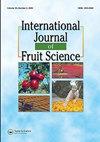不同灌溉制度下芒果茎秆的响应
IF 2.5
3区 农林科学
Q2 HORTICULTURE
引用次数: 1
摘要
墨西哥以高产、优质的芒果在国际芒果贸易中占据主导地位。利用土壤、植物和环境传感器可以监测植物的水分状况并优化水的应用。在一个高密度的8年龄商业芒果果园中研制并安装了线性电阻树枝计。2019年10个,2020年40个。每10分钟采集一次茎粗波动,得到最大直径(MXD)、最小直径(MND)、上午坡度(MS)和下午坡度(AS)。研究了日灌溉(DI)和减亏灌溉(RDI)对芒果开花、落果和果实生长过程中的茎秆响应。两种处理产量相近,但亏缺灌溉的水分利用效率更高。将8:00 - 18:00之间的所有值相加,得到一个新的变量-负积分(NI)。NI提供了茎干收缩幅度,归因于蒸腾的峰值和显示流向和流出树干的斜率。RDI-1花期NI与T7呈高相关(0.85)。如果NI超过零,则存在严重的应力;傍晚AS含量高,说明水果有营养液供给。果实产量取决于第一生产阶段的穗数和落果量,RDI-1在保果方面效率更高。本文章由计算机程序翻译,如有差异,请以英文原文为准。
Mango Stem Response under Different Irrigation Regimes
ABSTRACT Mexico has dominated the international mango trade having high yields and excellent fruit quality. The use of soil, plant and environmental sensors can monitor plant hydric status and optimize water application. Linear resistance dendrometers were developed and installed in a high-density 8-year old commercial mango orchard during two seasons; 10 in 2019 and 40 in 2020. Stem diameter fluctuations were acquired every 10 minutes to obtain maximum diameter (MXD), minimum diameter (MND), morning slope (MS) and afternoon slope (AS). Mango stem response during flowering, fruit-fall and fruit-growth was analyzed after applying daily irrigation (DI) or reduced deficit irrigation (RDI). Yield was similar for both treatments, but water use efficiency was higher with deficit irrigation. A new variable known as negative integral (NI) was obtained from the dendrometer signature after adding all the values between 8:00 and 18:00. NI provided a stem shrinkage magnitude, peaks attributed to transpiration and slopes showing flow transport to and from the trunk. NI presented a high correlation of 0.85 against T7 during the flowering stage for RDI-1. If NI crossed zero, a severe stress was present; a high AS present in the evening, indicates nutrient solution provided to fruits. Fruit yield depends on panicle number and fruit-drop during the first production stages, being RDI-1 more efficient in retaining fruits.
求助全文
通过发布文献求助,成功后即可免费获取论文全文。
去求助
来源期刊

International Journal of Fruit Science
Agricultural and Biological Sciences-Agronomy and Crop Science
CiteScore
6.40
自引率
0.00%
发文量
64
审稿时长
10 weeks
期刊介绍:
The International Journal of Fruit Science disseminates results of current research that are immediately applicable to the grower, extension agent, and educator in a useful, legitimate, and scientific format. The focus of the journal is on new technologies and innovative approaches to the management and marketing of all types of fruits. It provides practical and fundamental information necessary for the superior growth and quality of fruit crops.
This journal examines fruit growing from a wide range of aspects, including:
-genetics and breeding
-pruning and training
-entomology, plant pathology, and weed science
-physiology and cultural practices
-marketing and economics
-fruit production, harvesting, and postharvest
 求助内容:
求助内容: 应助结果提醒方式:
应助结果提醒方式:


